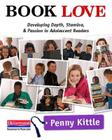If you teach middle or high school readers, then you need to read these books.
It's impossible for me to talk about teaching reading to 8th graders without referencing Kelly Gallagher's Readicide and Penny Kittle's Book Love. While other texts have shaped my teaching of middle schoolers, these are the two that have most influenced how I balance the texts in my classroom, and what I think about when I picture my students as high school freshmen.
My students are lucky. When they graduate 8th grade, they typically choose between two excellent Catholic high schools (one Jesuit, one all girls) and a top tier public high school. Students and their parents have a variety of reasons for choosing one over the others: the public high school is the largest by far, the theology requirement at the Jesuit school makes summer school pretty much mandatory, the appeal of single-sex education. But none of these schools, to my thinking, are particularly progressive when it comes to reading. Choice reading is pretty much done after they leave my classroom.
Several quotes jump off the pages as I flip back through my copy of Readicide:
- "Challenge all students with difficult text." (57)
- "Recognize the difference between liking a text and gleaning value from a text." (57)
- (Under "In developing recreational readers, teachers must. . .") "always keep the 50/50 Approach in mind. Do not allow recreational reading to be drowned in a tsunami of academic reading. Maintain a balance between the kinds of reading your students do. Place a higher value on fun reading." (117)
In the past, I have used Gallagher's 50/50 Approach (his recommended balance between what he calls recreational and academic reading) as a marker in my own classroom, where I balance between what I call independent reading and literature. Since I teach middle school, I have set that ratio at 70/30 or 60/40 depending on the grade I'm teaching. I remind myself that it doesn't matter if students like every text that I use with them as long as they "glean value" from reading it. It's okay to read hard things, but always, always, keep fun/recreational/choice/whatever-you-want-to-call-it at the center of the reading classroom. I'm constantly searching for the "sweet spot" that Gallagher talks about between over- and underteaching a text (90-91). I never let other priorities interfere with reading time at school or at home.
A Tale of Two Cities was the last book I finished in 2012; Penny Kittle's Book Love was the first in 2013. (Yes, this means I hadn't finished TOTC when I started reading it with my students. I know, I know. I did, of course, already know how it ended.) My students and I had read the first 10 installments of TOTC before the break. Reading Book Love reinforced for me that the independent reading that my students were doing would be more important than anything they learned from Dickens. Kittle writes in her book about building stamina, about preparing students for the hundreds of pages of reading that they would need to do each week in college. Likewise, I knew that my students would need to read a lot in high school, and that almost none of it would be of their own choosing. While their experience with TOTC would help with decoding difficult vocabulary and convoluted sentences, it was the hours they spent engrossed in Elizabeth Eulberg's The Lonely Hearts Club or T. M. Goeglein's Cold Fury that would prepare them for the volume of reading they would do in the future. Nobody gets faster at reading while reading Dickens. With this in mind, I could continue to share an installment of A Tale of Two Cities with my students each week without decreasing our independent reading goals by even one book.
How we did this, of course, is the subjects of its own post entirely.
Currently reading: Beautifully Unique Sparkleponies by Chris Kluwe
Why I'm reading it: Umm, did you see the title? Sparkleponies!



Lea -- I couldn't agree more. These two titles made a huge difference in the way I do my job.
ReplyDeleteI wish I'd read them back when I taught high school.
DeleteThis post reflects exactly how I feel about teaching reading. I, too, am always trying to find that perfect balance between over-teaching and under-teaching texts. I like the way you've adjusted to a 60/40 balance between SSR and assigned reading for middle school. It feels right to me too.
ReplyDeleteIn a perfect world/school, I think that balance would change a little bit each year as kids are ready for more challenging texts, without ever dropping the choice below 50% except MAYBE in AP. Alas. . .
Delete